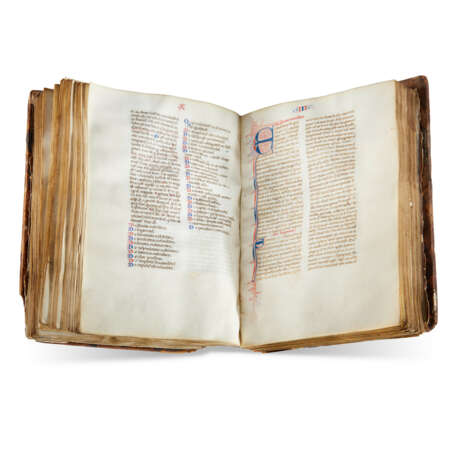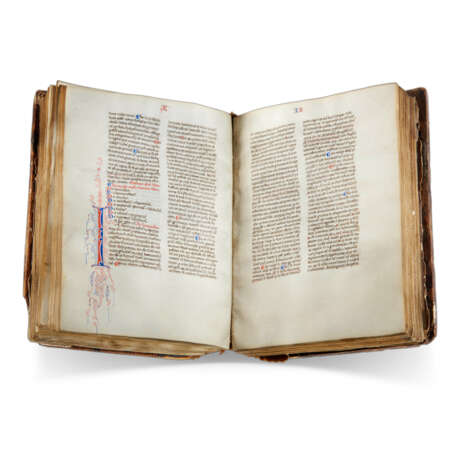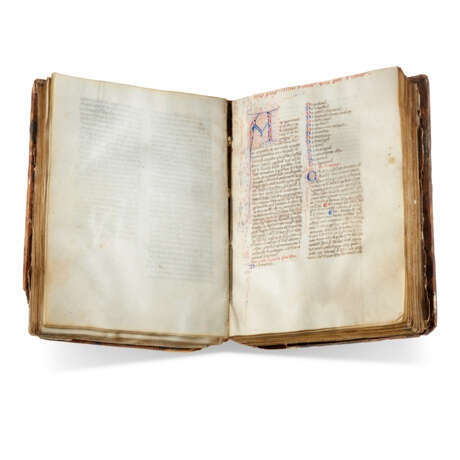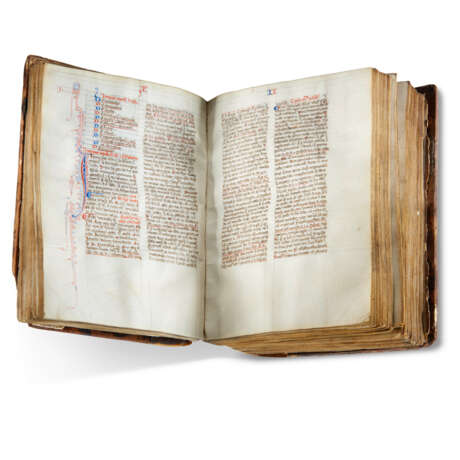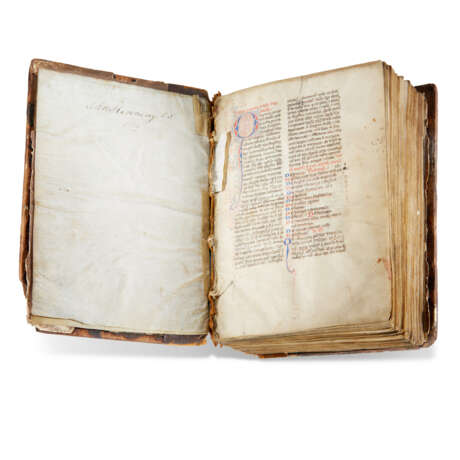ID 993339
Lot 38 | Raymond of Peñafort (1175-1275) and William of Rennes (fl. 1240–1245)
Valeur estimée
£ 25 000 – 35 000
Summa de poenitentiae et matrimonio and Apparatus in Summam Raymundi, in Latin, decorated manuscript on vellum [France (Paris?), c.1275-1300]
A rare witness to the penitential handbook that inspired Chaucer, accompanied by the apparatus of William of Rennes: the texts almost contemporary with the lives of their authors.
180 x 130mm. ii + 332 + ii leaves, complete, collation: 1-1510, 16-2012, 217(of 8, viii a cancelled blank), 22-358, 363(of 4, iv a cancelled blank), the Summa with contemporary foliation for each book in red on the versos, most catchwords survive, prickings visible, 37 lines in two columns, ruled space: 116 x 39-8-39mm., contemporary marginal annotations, rubrics in red, capitals touched in red, paraphs and small initials alternately red and blue, chapter headings in red and blue, elaborate penwork initials in red and/or blue with alternating flourishes extending into the margins throughout (occasional marginal thumbing and staining, ff.268-272 with a horizontal marginal cut not affecting text). Contemporary wooden boards covered in remnants of later? leather (spine restored, lacking clasp and catch). Fitted grey cloth box.
Provenance:
(1) A 19th-century inscription on the first flyleaf reads ‘Abbey Cambron’. This would be the Cistercian Cambron Abbey in Belgium, dissolved in 1782, but by the 13th century one of the wealthiest monasteries of Hainault with an important library (many of the surviving manuscripts from this library are inscribed – often repeatedly – ‘de Camberone’, an inscription not found in the present manuscript).
(2) ‘John Kennedy C.S. 1833’: ownership inscription on the second flyleaf. The Schoenberg database identifies him as John S. Kennedy (presumably the art collector and financier John Stewart Kennedy), but the dates do not match.
Content: Raymond of Peñafort (1175-1275), Summa de poenitentiae et matrimonio, beginning 'Incipit Summa Magistri Raymundi / Quoniam ut ait Ieronimus', ff.1-149: Book I f.1, Book II f.38v, Book III f.65, Book IV f.126v; definitions and concordances ff.145v-149; Prayers of Saint Ambrose before Mass for each day of the week (today ascribed to John of Fécamp [d.1079]), beginning ‘Summe sacerdos et vere pontifex’ ff.149v-150; William of Rennes (fl. 1240–1245), Apparatus, ff.151-331v: Book I f.151; Book II f.186v; Book III f.215; Book IV f.300; blank f.332.
The great Catalan canonist Raymond of Peñafort had studied and taught philosophy at Barcelona before moving to Bologna to study law. In 1222, having returned to Spain, he joined the Dominicans. During the next few years he wrote the Summa de poenitentiae, the hugely influential penitential handbook that Chaucer used as the basis for large parts of the ‘Parson's Tale’. In 1230 Gregory IX summoned him to Rome and appointed him first confessor and then chaplain and grand penitentiary. He was charged with rationalizing the existing body of papal decrees, and his completed work became the standard collection accepted by canonists. In 1236 he returned to Spain and two years later, against his wishes, was appointed General of his order. In this role he revised the Dominican constitutions and this revision remained in force until 1924.
The present manuscript contains the three Books of the Summa de poenitentiae, or Summa Casuum, which were composed between 1222 and 1225, followed by De Matrimonio. The latter was written after Raymond had revised the Summa around 1234. It is an updated version of the treatise of the Bolognese canon lawyer Tancred and was often circulated separately.
These texts are followed by the apparatus of the otherwise unknown Dominican William of Rennes (Guillelmus Redonensis, fl. 1240-45). His commentary was transmitted alongside Raymond’s work in most of the manuscripts and early editions and enjoyed an almost equal authority during the later Middle Ages.
The printed edition of 1603 wrongly attributed this apparatus to Johannes of Freiburg (Summa Sti Raymundi de Peniafort De Poenitentia et Matrimonio cum glossis Ioannis de Friburgo (Rome, 1603: reprint Farnborough 1967): Universa Bibliotheca Iuris.
The text survives in the following institutional manuscripts: Alençon, BM 140; Angers, BM 219 (as a separate text, without Raymond’s Summa); Arras, BM 122; Berlin, Staatsbibl. lat. oct. N.92; Clermont Ferrand, BM 91; Erlangen, Universitätsbibl. 523; Fulda, Landesbibl. D.12; Göttingen, Universitätsbibl. C.m.j.163; Leipzig, Universitätsbibl. 1009 and 1014 (as a separate text); Melk, Stiftsbibl. B.78; Munich, Clm 5943, lat. 8219, lat. 8884; Prague, Universitätsbibl. III.F.15; Tours, BM 368; Troyes, Bibl. Munic. 1710 and 1863; Vienna, ŐNB lat. 1372; Wroclaw, Univ. II.F.111 and 112.
Special notice
No VAT is payable on the hammer price or the buyer's premium for this lot. Please see the VAT Symbols and Explanation section of the Conditions of Sale for further information
| Artiste: | Raymond de Peñafort (1175 - 1275) Guillaume de Rennes (1240 - ?) |
|---|---|
| Lieu d'origine: | Europe de l'Ouest, France, Europe |
| Catégorie maison de vente aux enchères: | Manuscrits médiévaux et de la Renaissance |
| Artiste: | Raymond de Peñafort (1175 - 1275) Guillaume de Rennes (1240 - ?) |
|---|---|
| Lieu d'origine: | Europe de l'Ouest, France, Europe |
| Catégorie maison de vente aux enchères: | Manuscrits médiévaux et de la Renaissance |
| Adresse de l'enchère |
CHRISTIE'S 8 King Street, St. James's SW1Y 6QT London Royaume-Uni | |
|---|---|---|
| Aperçu |
| |
| Téléphone | +44 (0)20 7839 9060 | |
| Commission | see on Website | |
| Conditions d'utilisation | Conditions d'utilisation |
